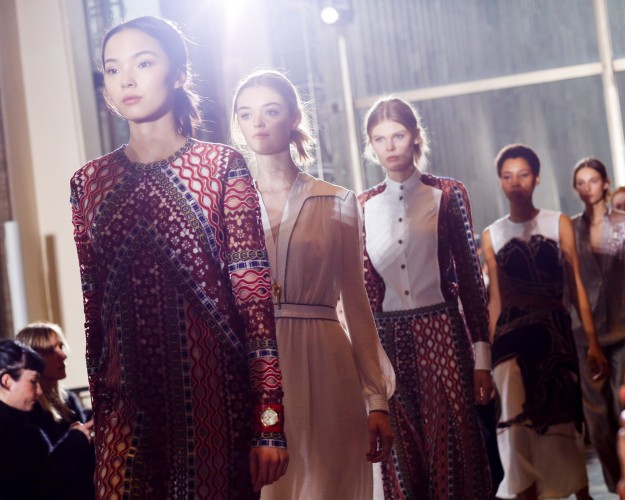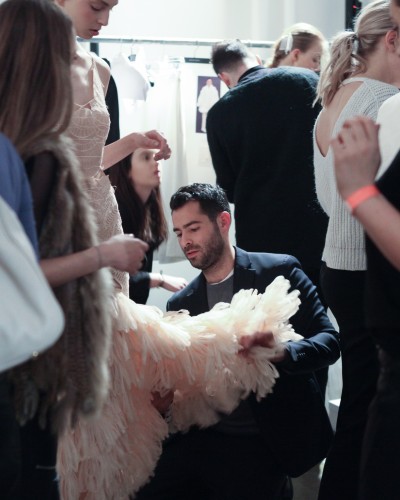Booth Moore’s NYFW Diary: Marc Jacobs’ Thought-Provoking End to Fashion Week
February 19, 2016


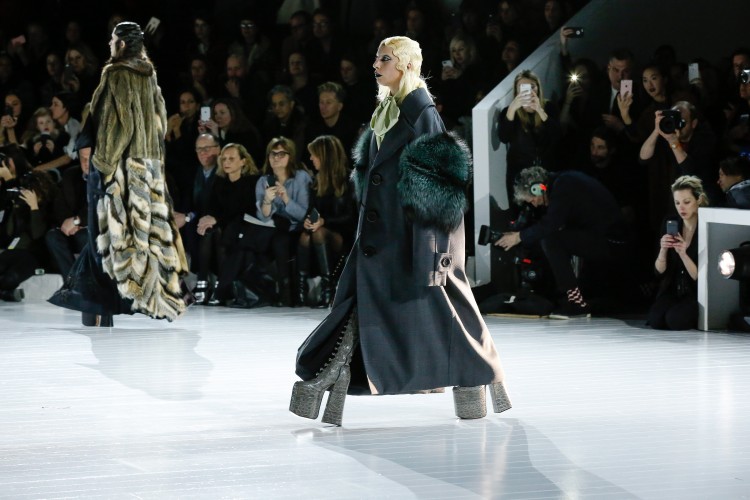

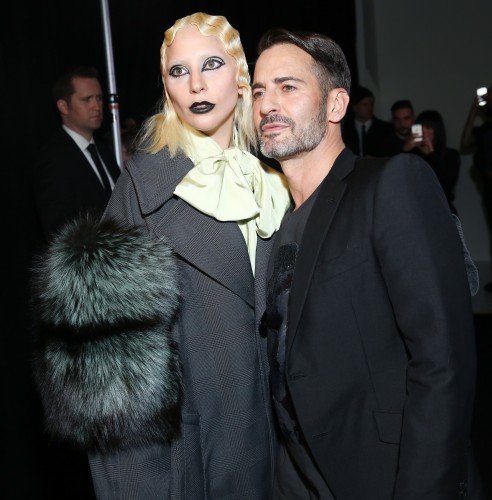
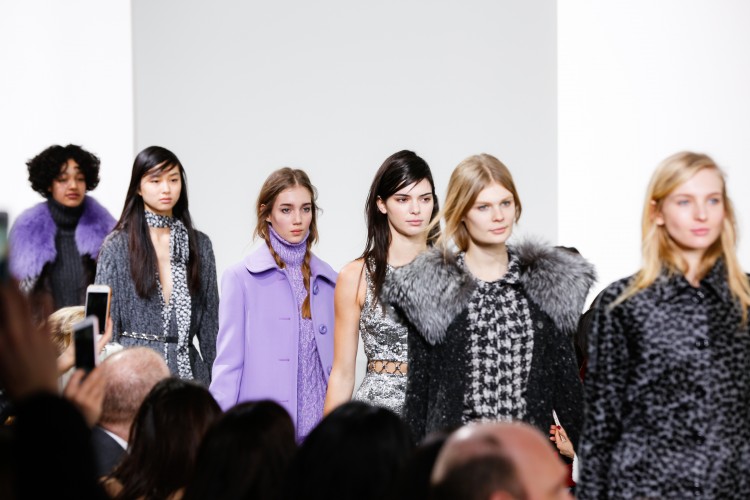
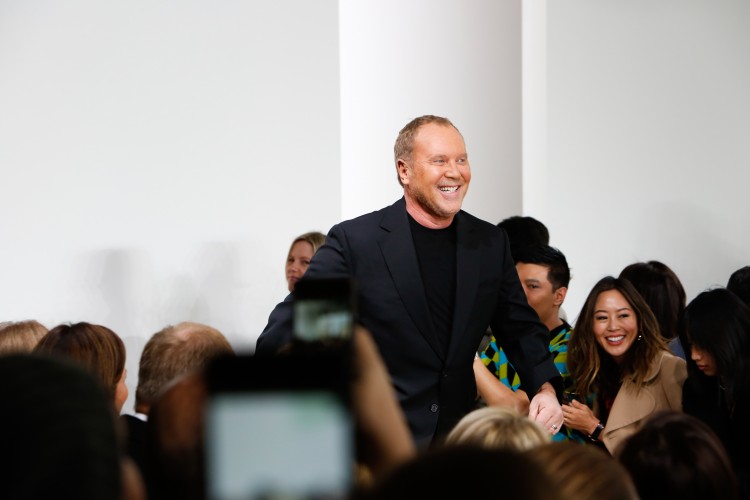
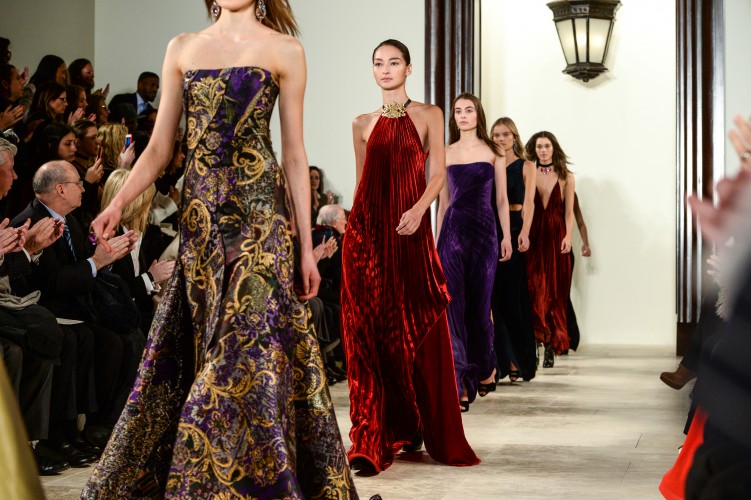



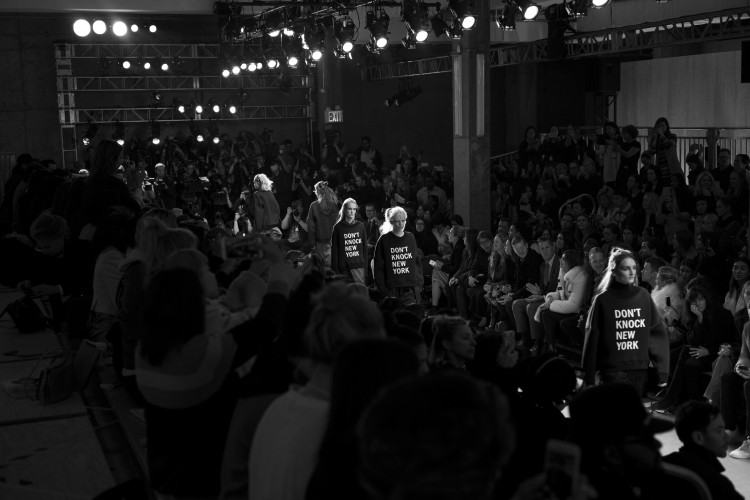
Lady Gaga walking in the Marc Jacobs
Marc Jacobs
Lady Gaga and Marc Jacobs
Alexandra Elizabeth, Kendall Jenner
Michael Kors
Ralph Lauren
Ralph Lauren
Calvin Klein
Proenza Schouler
DKNY
Was it a requiem for fashion as we know it? That’s what went through my mind watching Marc Jacobs’ finale to New York Fashion Week.
It was a hauntingly beautiful runway spectacle that was itself a comment on the runway spectacle, and from American fashion’s master showman no less, who helped bring us to this moment of runway as stage in the Internet age.
Last season’s Marc Jacobs blockbuster was held at the landmark Ziegfeld Theatre, complete with branded Playbills, popcorn and a runway that started on a public sidewalk. This season, the show was staged in the round, with a stark white set. Inside the show notes was a concise creative statement about singer-songwriter Keiji Haino, the Japanese concept of Ma (which translates as pause), and defying the notion that that you can’t create something from nothing.
To the sounds of Haino’s repetitive, meditative chimes, the first model stepped out casting an enormous shadow on the back wall, followed by the next and the next. The shadow play loomed large over the runway — just as the pressure to entertain an online public, and adapt business to new technology and communication, is looming large over the industry. It was a pause for reflection.
The clothes were costumes of over-the-top Goth and Victoriana elegance married with the street. Oversized silhouettes with richly textured embellishment cast ever bigger images on the blank white wall. Outerwear romanced, including a dramatic green coq feather-trimmed tweed coat, a distressed gray denim jacket customized with chains, patches and pins, and a multilayered fur coat. Bow blouses, floor sweeping skirts and extreme platform shoes added to the vision of dark glamour. And several pieces, such as a distressed gray “Bobcat” sweatshirt with lace collar resembling grandma’s doily, had a DIY spirit that seemed a longing for a time in fashion when creativity was all you needed, along with a pair of scissors.
Jacobs cast pop icon and “American Horror Story: Hotel” star Lady Gaga as one of his models, though she was practically unrecognizable in 1920s pin curls and glam rock makeup. A celebrity in disguise, what a concept.
There was a lot to contemplate in the shadows and empty space–about the meaning of fashion; selling a dream vs what sells in reality; the runway as intimate shared experience vs. shared public spectacle; and what might be gained and lost as the system evolves.
The Proenza Schouler collection was thought-provoking, too. Stellar knitwear and fluid tailoring showed off rigorous lacing, wrapping and tying techniques that had to be seen up close to be fully appreciated, not unlike the artwork at the Whitney Museum, where the show was held.
Jack McCollough and Lazaro Hernandez were inspired by the ideas of control and release, according to the show notes, which also detailed the designers’ own buy-now initiative–making part of the fall collection available in their New York store now.
Control and release is a great metaphor for the state of fashion. In a cultural context, we are the one percent who have for decades enjoyed privileged access, exclusive experiences and the ability to be the gatekeepers of taste and information. But the revolution is here in the form of consumer-driven shows, straight-to-retail collections, media and retail reorganization. And that means ceding control and letting the rest of the world in.
Some worry that when the novelty of instant access to runway collections wears off, the public will move on, and the industry will be back in the same spot it finds itself in now.
Others insist change is necessary to turn the smart phone from enemy to asset. That means using technology to make the runway-to-retail experience as seamless as possible for customers who spend their lives online, says Neiman Marcus Fashion Director Ken Downing.
As the system evolves, so do the clothes at fashion’s legacy brands. Oscar de la Renta’s Peter Copping seduced a new generation with subtle corset details, playful outsize bows and jeweled-heel pumps.
In recent years, Michael Kors has gone from socialite as muse, to social media-ite as muse. “Instaglam” is how he described his whimsical fall collection of look-at-me looks, including ostrich feather embroidered jeans, sequin streamer skirts, and powder blue floral intarsia mink coats.
Ralph Lauren also played to the social media set’s appetite for eclecticism, with a wide range of looks from tweedy herringbone jackets and pleated pants, to crushed velvet rock n’ roll frock coats and flared jeans, to ruffle-tipped after-5 tuxedo looks. The new ‘social’ set sat front row, including Bryanboy, Man Repeller Leandra Medine and The Blonde Salad’s Chiara Ferragni.
At Calvin Klein Collection, Francisco Costa continues to rekindle the brand’s sexy, 1990s history (also reflected in the successful #MyCalvins social media campaign, which has everyone from Justin Bieber to the guy next door posing in their underwear). This season, he showed deconstructed, S&M-tinged tailoring, contrasted with naturalistic animal print pieces and sunburst pleat gowns inset with polished stones and geodes.
And DKNY’s Maxwell Osborne and Dao-Wi Chow courted “likes” with supersized 1990s hip hop-inspired trousers, bomber jackets and slip dresses with athletic lacing details. They also remixed the brand’s iconic 90s-era logo on T-shirts and sweats, spelling out the words “Don’t Knock New York” and “Designers Know Nothing Yet.”
Those may have been the truest ideas communicated all week. Designers don’t know, retailers don’t know, and editors don’t know either. All we can do is pause, take a deep breath, and hope for the best.
